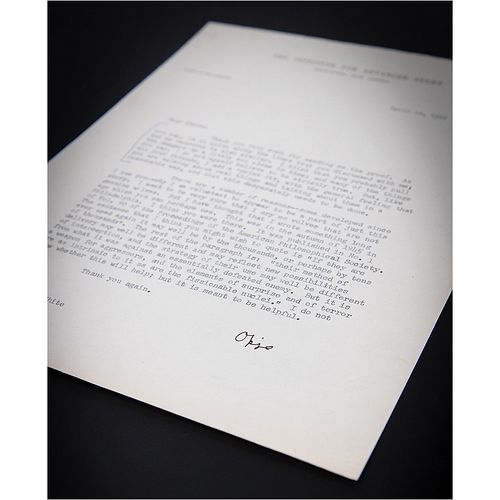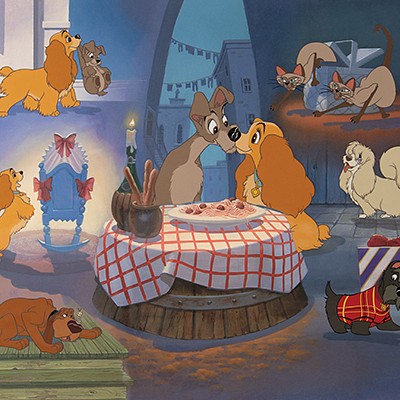Robert Oppenheimer Typed Letter Signed on Russia and the Atomic Bomb: "It is a weapon for aggressors"
Two ways to bid:
- Leave a max absentee bid and the platform will bid on your behalf up to your maximum bid during the live auction.
- Bid live during the auction and your bids will be submitted real-time to the auctioneer.
Bid Increments
| Price | Bid Increment |
|---|---|
| $0 | $5 |
| $50 | $10 |
| $200 | $25 |
| $500 | $50 |
About Auction
Mar 13, 2024
RR Auction's March 2024 Fine Autographs and Artifacts auction features 650+ rare and remarkable items. The sale is highlighted by a robust selection of original animation artwork, including Eyvind Earle's remarkable landscape panoramas, Mary Blair's whimsical concept paintings, and production cels from Walt Disney classics like Snow White, Pinocchio, Lady and the Tramp, Peter Pan, and Cinderella. RR Auction support@rrauction.com
- Lot Description
TLS signed “Opie,” one page, 8 x 11, The Institute for Advanced Study letterhead, April 16, 1952. Letter to Stephen White of Look Magazine, commenting on a draft of his article, 'Russia's Newest Threat: A-Bomb Supremacy.' In full: "Thank you very much for sending me the proof. As you say, it is quite along the lines that you discussed with me; and my response is also similar. I think that you probably pull the dangers up a little too close in time; and many of the things you say, I do not let myself believe to be strictly true. But, like all your friends, I add a 'print it,' with the general feeling that you are talking about real things and talking about them in a reasonable way, and that this desperately needs to be done.
There are a number of reasons—some developed since I saw you—why I am reluctant to appear to be a part of just this story. I want to be very sure that I cry no wolves that are not genuine wolves. But I have thought that I wrote, something long ago which you can perhaps use. This was in the autumn of 1945 in Philadelphia. I think you were there. It was published in No. 1 of Vol. 90 of the Proceedings of the American Philosophical Society. The sentence that I think you might wish to quote is 'If they are ever used again it may well be by the thousands, or perhaps by tens of thousands.' The rest of the paragraph is: 'their method of delivery may well be different and may reflect new possibilities of interception, and the strategy of their use may well be different from what it was against an essentially defeated enemy. But it is a weapon for aggressors, and the elements of surprise and of terror are as intrinsic to it as are the fissionable nuclei.' I do not know whether this will help; but it is meant to be helpful." In fine condition.
Stephen White's article, warning of Russia's ever-growing stockpile of nuclear weapons, appeared in the June 3, 1952 issue of Look. White warned of the dangers of a Soviet stride toward atomic supremacy, observing: 'For 6 years the people of the United States have thought of the atom bomb as their shield and their weapon...The shield is crumbling. The weapon is being turned against us. Just as the Russians stunned Americans by revealing the MIG jet plane and with it winning mastery of the skies over the Yalu, so they may soon be in a position to threaten America with America's own weapon.'
So important was this article that Congressman Melvin Price, later chairman of the Joint Committee on Atomic Energy, read it into the Congressional Record to advocate for the maintenance of American atomic supremacy and for holding Russian aggression in check. In the article, White noted that he consulted numerous experts and officials while preparing the article, alluding to the imperative of Oppenheimer and others to "print it": 'Atomic energy is so wrapped in secrecy that no official feels free to speak of it except in vague and remote allusions...This reporter has asked blunt questions about the new state of affairs. He asked them even though he knew that no responsible official would give him a direct answer. The law forbids talking for the record. But there was one significant comment each time. When he described the story he planned to write, he was invariably told grimly, 'Print it.''
The Soviet Union had carried out their first atomic test in 1949, while Oppenheimer was serving as chairman of the U.S. Atomic Energy Commission's General Advisory Committee. In that role, he lobbied to avert nuclear proliferation and end the arms race with the Soviet Union. He also chaired the five-member State Department Panel of Consultants on Disarmament, which first urged that the United States postpone its planned first test of the hydrogen bomb and seek a thermonuclear test ban with the Soviet Union, on the grounds that avoiding a test might forestall the development of a catastrophic new weapon and open the way for new arms agreements between the two nations. Oppenheimer's opposition to the H-bomb, along with alleged ties to the Communist Party, ultimately led to the suspension of his security clearance in 1954. - Shipping Info
-
Bidder is liable for shipping and handling and providing accurate information as to shipping or delivery locations and arranging for such. RR Auction is unable to combine purchases from other auctions or affiliates into one package for shipping purposes. Lots won will be shipped in a commercially reasonable time after payment in good funds for the merchandise and the shipping fees are received or credit extended, except when third-party shipment occurs. Bidder agrees that service and handling charges related to shipping items which are not pre-paid may be charged to a credit card on file with RR Auction. Successful international Bidders shall provide written shipping instructions, including specified Customs declarations, to RR Auction for any lots to be delivered outside of the United States. NOTE: Declaration value shall be the item’(s) hammer price and RR Auction shall use the correct harmonized code for the lot. Domestic Bidders on lots designated for third-party shipment must designate the common carrier, accept risk of loss, and prepay shipping costs.
-
- Buyer's Premium



 EUR
EUR CAD
CAD AUD
AUD GBP
GBP MXN
MXN HKD
HKD CNY
CNY MYR
MYR SEK
SEK SGD
SGD CHF
CHF THB
THB





